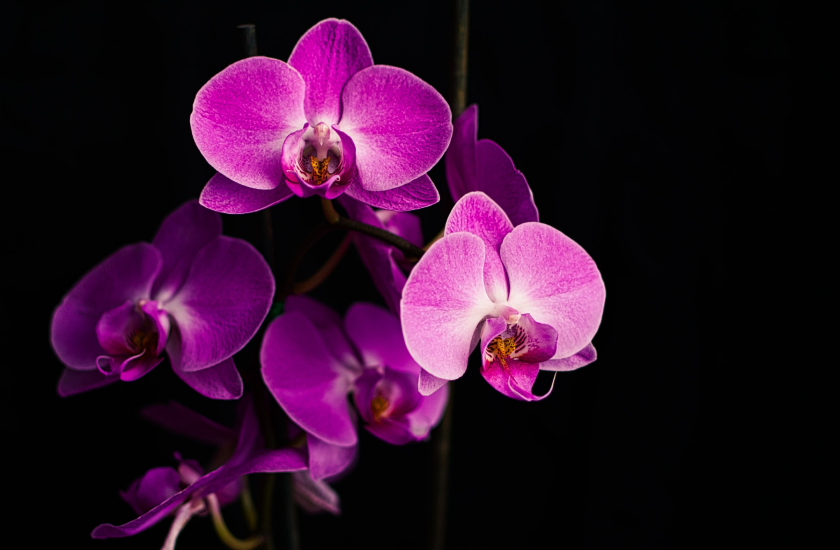Orchid
Our Brochures
Contact Us
Social Media


- Family: Orchidaceae
- Habitat: Predominantly in tropical areas, but some species can be found in temperate climates.
- Flowering: Throughout the year, depending on the species. The flowers are known for their bilateral symmetry and a wide array of vibrant colors and unique patterns.
- Reproduction: Through pollination, often by insects, and asexual reproduction through pseudobulbs or keikis.
Orchid varieties
- Phalaenopsis: Also known as the “moth orchid” due to the shape of its flowers.
- Cattleya: Orchids with large, fragrant flowers, commonly used in corsages.
- Dendrobium: This genus contains a variety of species with diverse flower shapes and sizes.
- Oncidium: Known for their branched inflorescences and small, detailed flowers.
- Vanda: This genus is known for its bright and vibrant flowers.
Common Uses
- Ornamental: Extensively used in floral arrangements and for decorating interiors and gardens.
- Perfumery: Some species of orchids are used to create exquisite fragrances.
- Culinary: Vanillin, the main component of vanilla extract, is derived from the pod of the Vanilla orchid.
Production and Export Process Orchids
Propagation and Nursery Phase
- Seed Sowing: Orchids can be propagated using seeds, which are sown in sterile media under controlled environmental conditions. It is a labor-intensive and time-consuming process that requires great attention to detail.
- Tissue Culture: Another common propagation method is through tissue culture, where new plants are generated in a lab from existing plant tissues. This process allows for the mass production of orchids.
- Transplanting: Young orchid plants (protocorms or seedlings) are then transplanted into a nursery for further growth. They are nurtured in a controlled environment with the appropriate light, temperature, and humidity levels.
Cultivation Phase
- Growth: After reaching a sufficient size, the plants are moved to the main cultivation area. They are grown in greenhouses with controlled environmental conditions to foster optimal growth.
- Nutrient Management: Proper nutrient management is critical. Orchids require specific fertilizers and nutrient solutions to grow and flower adequately.
- Pest and Disease Management: Regular monitoring is required to manage pests and diseases effectively. Integrated Pest Management (IPM) strategies are often implemented to control pests and diseases while minimizing environmental impact
Harvest Phase Harvesting:
- Orchids are harvested when the flowers are in the perfect stage of blooming. The harvest stage can vary depending on the purpose (e.g., for fresh flowers or for plant sales).
- Post-Harvest Handling: After harvest, the flowers and plants undergo a post-harvest handling process to ensure their longevity. This process may include cooling, hydration, and the application of preservatives.
Export Phase Packaging:
- Orchids are packaged carefully to prevent damage during transit. The packaging process involves using materials that can provide cushioning and support to the delicate flowers.
- Documentation and Compliance: Before export, the necessary documentation is prepared, and the orchids must comply with the phytosanitary requirements of the importing country.
- Transport: The packaged orchids are transported to the destination. The transportation is usually carried out in refrigerated containers to maintain the freshness of the flowers.
- Market: Once they reach the destination, the orchids are distributed to various markets, including wholesalers, retailers, and flower shops.
Places Where It Is Grown
- Thailand: One of the world’s largest exporters of orchids, with a massive cultivation industry primarily centered around the Dendrobium, Vanda, and Cymbidium varieties.
- Netherlands: A prominent player in the global orchid market, cultivating a wide variety of orchids including Phalaenopsis, which is hugely popular in the country.
- Colombia: A country with a rich diversity of wild orchids, it has also established itself in the commercial orchid cultivation market, producing a wide range of orchid varieties.
- Ecuador: Known for its rich biodiversity, Ecuador is home to a large number of native orchid species and has a blossoming orchid cultivation industry.
- Taiwan: A significant producer of orchids, particularly the Phalaenopsis variety. The country has invested in advanced cultivation techniques to enhance the quality and variety of its orchids.
- United States (Florida and Hawaii): In the US, Florida and Hawaii are known for their orchid cultivation. The regions have numerous orchid farms supplying a variety of orchids both for the domestic and international markets.
- India: Home to a wide range of native orchid species, India has regions like Sikkim and the Northeastern states where orchid cultivation is prominent.
- China: With Yunnan and Sichuan provinces being hotspots, China has a growing orchid cultivation industry, leveraging its rich biodiversity of native orchid species.
- Australia: The country has native orchid species, and orchid cultivation is a budding industry with a focus on both native and exotic varieties.
- Philippines: Home to numerous indigenous orchid species, the Philippines has been increasingly engaging in orchid cultivation, with an emphasis on sustainable practices.
- Malaysia and Indonesia: Both countries are home to a variety of native orchid species and have a burgeoning industry for orchid cultivation.
Note:
Altitude and Climate: Different orchid species require different climates, and altitudes and their cultivation regions are chosen accordingly. Some thrive in tropical conditions, while others prefer temperate or high-altitude environments.
Conservation: Many regions are focusing on conservation efforts to protect native orchid species from overharvesting and habitat loss due to various factors including climate change and deforestation.
Medicinal Uses
- While orchids are not typically recognized for their medicinal uses, some cultures utilize orchids to treat various conditions:
- Traditional Treatments: In some cultures, they are used to treat mild illnesses and ailments.
- Nutritional Supplements: Some studies have shown that orchids contain flavonoids and other compounds that may have health benefits.
